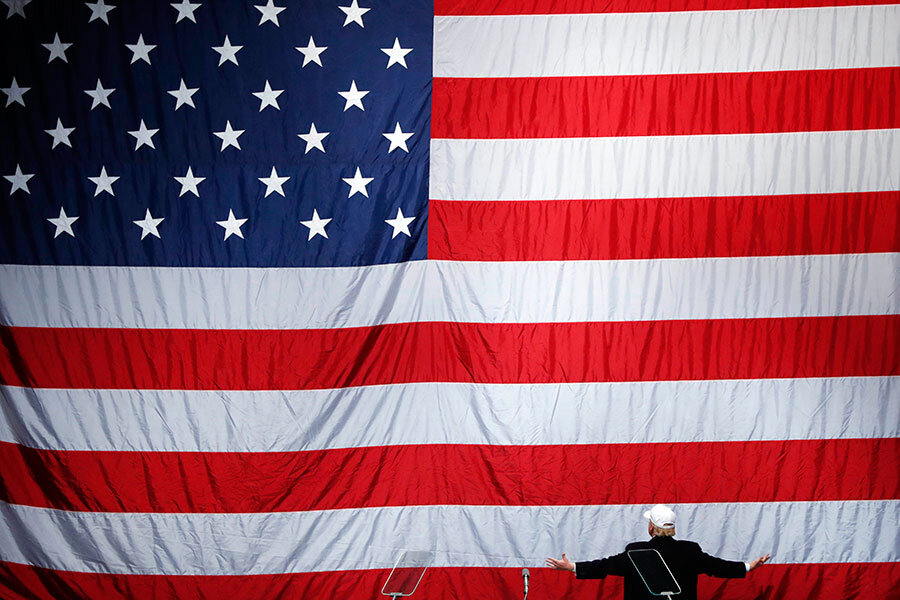Trump has dramatically shifted fault lines of American politics
Loading...
Donald Trump’s stunning victory in the presidential election of 2016 has upended generations-old Washington verities, shaking everything from the fixed catechisms of the Republican and Democratic parties to the contours of the red/blue election map and the relative power of big demographic voting blocs.
“Right versus left” seems an inadequate description of the new US governing landscape. “Closed versus open” or “domestic versus globalist” might be more accurate, given Mr. Trump’s opposition to the status quo of immigration and free trade and the increasing concentration of minorities and more-educated voters on the Democrat side of the aisle.
Trump’s unique populism promises a change in governance perhaps equal to parts of the New Deal or the early years of the Reagan revolution. Whether he can deliver on that promise, or means to, will be Question No. 1 following Inauguration Day 2017.
“I do think we are seeing a shift in the fault lines of American politics,” says Brian Balogh, a professor of history at the University of Virginia and co-host of the popular podcast “Backstory with the American History Guys.”
“This is less about ideology, and more about tapping into a nationalistic sentiment in an increasingly global environment,” he adds.
Familiar ... and not
In some ways, Trump’s defeat of Hillary Clinton was the doing of a typical Republican electoral coalition. At the close of the campaign, many party members drifted back to their standard-bearer after toying with third-party candidates or nonvoting.
“The Republican Party simply came home ... even though many of its elites remained appalled [by Trump’s candidacy],” said Elaine Kamarck, a senior fellow in the governance studies program at the Brookings Institution, at a day-after seminar on the election results.
But in other ways it wasn’t. Trump vastly outperformed 2012 nominee Mitt Romney among white males without a college degree. Trump won them by 39 percentage points, according to exit polls, as opposed to Romney’s 25-point margin.
This different mix helped draw the GOP a different winning map. Perhaps its biggest surprise was the swath of red at the top of the middle.
Trump won Wisconsin, Michigan, and Pennsylvania, all states that have long eluded the Republican Party’s grasp in presidential votes. To some extent, this probably surprised even him – Trump barely campaigned in the first two of those states. But his appeal to the white working class and its grievances with free trade and lost blue-collar jobs overcame the Democratic Party’s increasingly shaky reliance on the region’s remaining industrial union vote. They’re now likely toss-ups, if not part of the new populist GOP coalition.
These are a part of America marked by the pain of “deindustrialization,” said Stuart M. Butler, a Brookings Institution senior fellow in economic studies, at the Wednesday seminar. “These are people who feel the VA has let them down, they can’t get an appointment, there are potholes in the road,” said Mr. Butler.
Past 'Trumps'
Trump convinced them he feels their pain. In that sense, he is a populist somewhat reminiscent of the late-19th/early-20th century Democratic orator William Jennings Bryan, or perhaps The Kingfish, Depression-era Louisiana governor and political boss Huey Long, says Professor Balogh of the University of Virginia.
Trump shares with those antecedents an appeal to “a group of people who feel they are not being adequately represented” on the national stage, he says.
Or perhaps the best historical analogy is to an even earlier figure, President Andrew Jackson.
In many ways Old Hickory is Trump’s “closest comparison” in terms of US political figures, says Bert Rockman, a professor of political science emeritus at Purdue University.
Jackson embodied the grievances – and racial prejudices – of a white lower class that felt excluded from the circles of power prior to his rise, Professor Rockman notes.
Like Jackson did, Trump is promising to reorder national priorities to help this aggrieved population. That means his agenda centers on immigration restrictions, a pullback on free trade, a less interventionist foreign policy, and generally inward-looking policies that cut against the globalist tendencies of the nation’s educated upper classes.
“The big problem is that this was in many ways an election between America’s past and its future, and the past won,” says Rockman.
President Trump’s challenge will be implementing such an approach in an increasingly technological and interconnected world.









